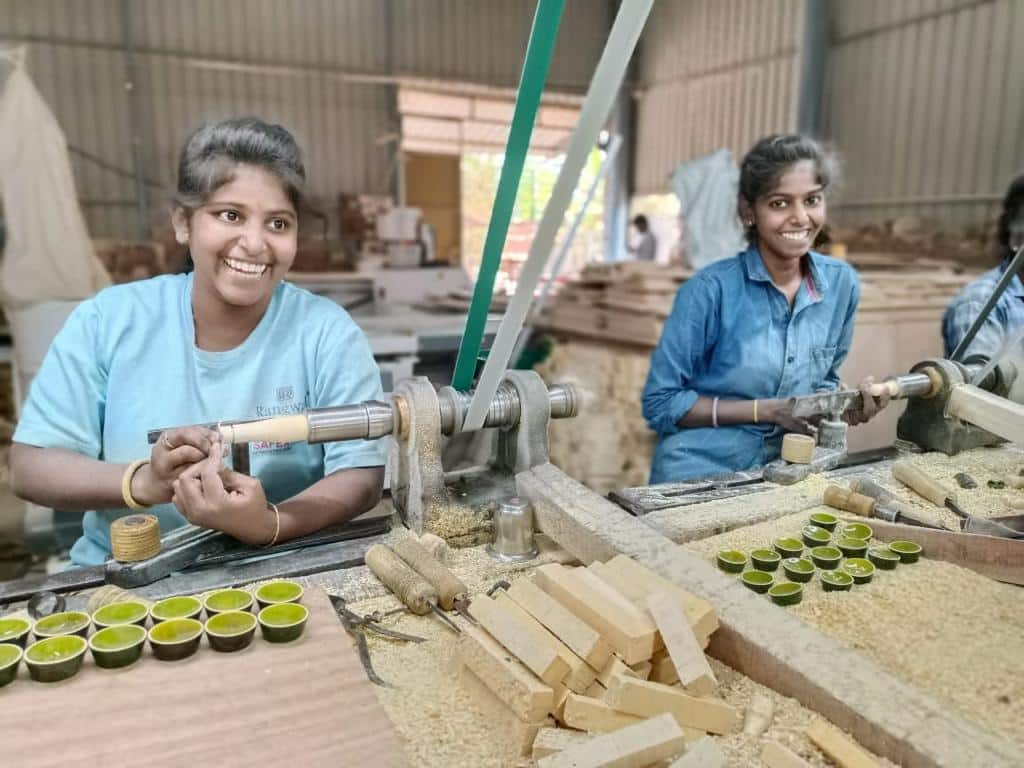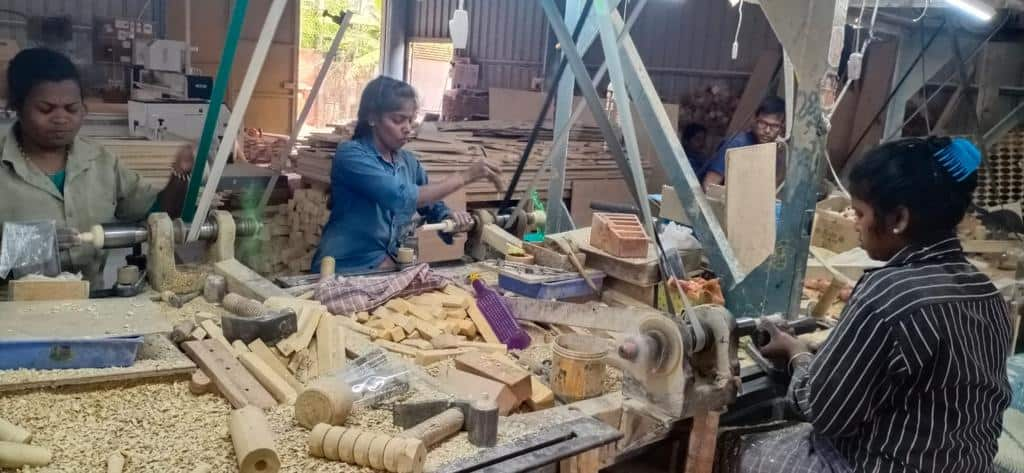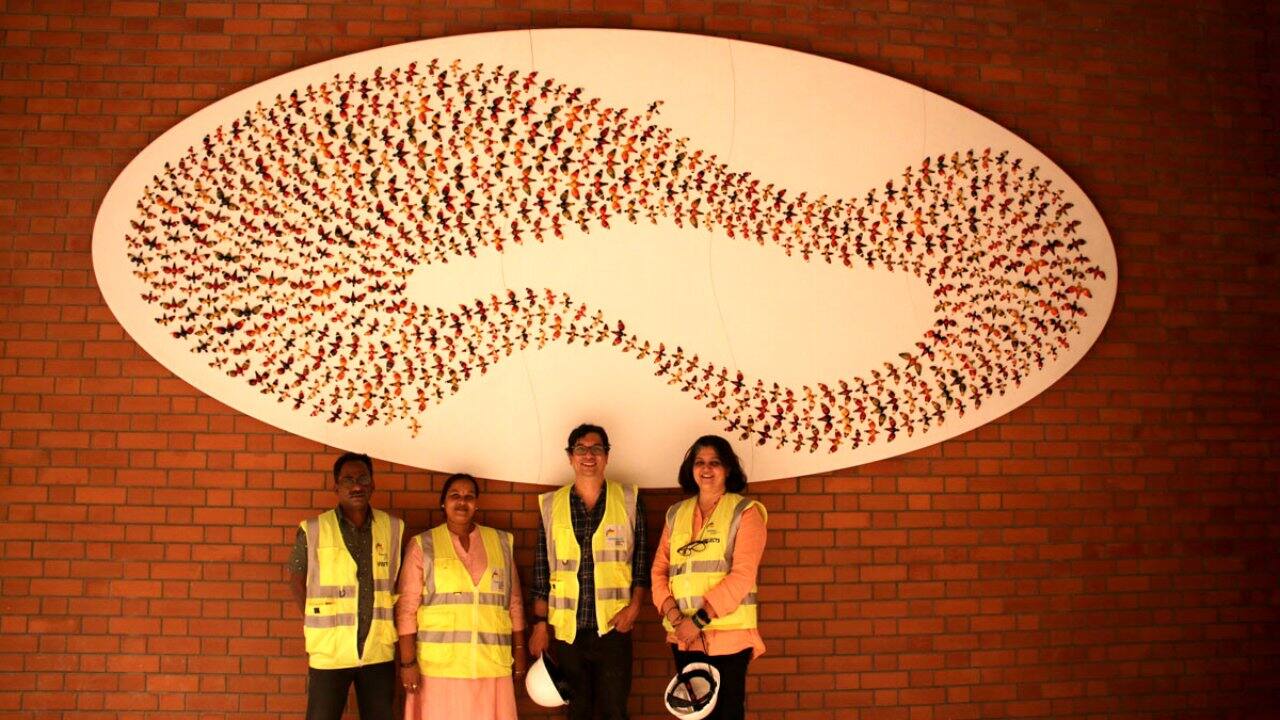



At the new Terminal 2 of Bengaluru’s Kempegowda International Airport, a set of 750 birds catches the eyes of travellers and gawkers. The ‘Flights of Wonder’, inspired by the murmuration of swallows, was created by city-based artist Ravikumar Kashi using an assemblage of wooden birds traditionally crafted by Channapatana artisans. According to the artist, when he discussed the brief with the airport authorities, he was clear that he wanted to initiate a dialogue with the local artisans.
This has, in many ways, thrown a spotlight on the traditional craft of Channapatna, a small town approximately 70 kilometres from Bengaluru. Locally known as gombegal ooru (toy town), the town is famous for its wooden toys which are handmade by the artisans, using simple tools including a hand-turned lathe and lacquered with natural colour pigments.
 Channapatna toy makers (Photo credit: Suhel Parvez, Bharat arts and craft)
Channapatna toy makers (Photo credit: Suhel Parvez, Bharat arts and craft)The art is about 300 years old with varying theories about its origin. It was said to have been patronized by Tipu Sultan (ruled Mysore Kingdom from 1782-99) who invited Persian artisans to train the local artisans in Persian ways of making wooden toys, and it underwent a significant change last century when Bavas Miyan, considered the Father of Channapatna toys, introduced the Japanese dollmaking methods (the use of lathe instead of hand pathri) to the craft.
Over the years, the artisans have faced competition from cheap Chinese look-alike wooden dolls (which were later banned) and survived a steep drop of income during Covid and today, after seeing a brief revival, they are in doldrums. “There were 150 outlets along the old Bengaluru-Mysuru highway till last year,” said 33-year-old Suhel Parvez, a fifth-generation artisan. “After the bypass was built (the newly inaugurated Bangalore-Mysore expressway), there are hardly 20 shops. The rest have shuttered down.” This period is probably the worst that the Channapatna artisans have faced in so many decades. “It is very bleak for them,” Kashi said. “Their main avenue for sale has been closed. The artisans are not trained to think like a designer so it is imperative that designers and artists collaborate with them and do some design interventions.”
Karthik Vaidyanathan, founder of the Varnam Craft Collective, an award-winning social enterprise, has been doing such design interventions for over a decade. He calls Varnam a “livelihood initiative” wherein the collective tries to ensure regular work for the artisans so that they don’t leave the craft. “People don’t continue a craft if they don’t have a regular income,” he said. The Varnam stores have contemporary products made by the Channapatna artisans with home and lifestyle products including lighting, kitchen, dining and bar accessories, toys, board games and jewellery.
Vaidyanathan views the new expressway as the latest blow to the Channapatna artisans. The problems have been there for a decade now, he said. “Over the last several years it has been a downward journey in many ways, although there is no dearth of demand for our products, it has become very difficult to ensure there is a continued production. There are several reasons for this, first, it is a tough job to work with natural colours and mixing colours. Then the wood must be properly seasoned.” Kashi too had to sit with the artisans for long hours to finally come up with 45 different colour combinations using the seven natural colours that are available.
 Channapatna suffers from frequent and prolonged power cuts affecting the productivity of the units. (Photo credit: Suhel Parvez, Bharat arts and craft)
Channapatna suffers from frequent and prolonged power cuts affecting the productivity of the units. (Photo credit: Suhel Parvez, Bharat arts and craft)Channapatna suffers from frequent and prolonged power cuts affecting the productivity of the units. “Another issue is that most of the units are owned by proprietors who aren’t artisans,” Vaidyanathan said. “There are constant tensions between the unit heads and the artisans. Caste and gender dynamics further worsen the situation. This is why the concept of a collective does not work in Channapatna. Also, many artisans prefer making products for local shops and businesses where there is no quality check rather than striving to contemporize their craft in accordance to stringent standards.”
Today, according to Parvez, more than 80 percent of the artisans have left their craft. “Our presentation and packaging are not good so we don’t sell toys online. Earlier we used to do ‘white label’ manufacture which is to make products for larger stores and brands but that too, over the past few months, has become very low. Summers used to be the peak time for our business. Not anymore. Export orders are nonexistent.” He remembers fondly the time when Barack Obama had visited in India in 2015 and had specifically asked for Channapatana toys for the White House.
How does the future look like? Parvez doesn’t want to dwell on it. “We are concentrating on making a proposal to the DC, requesting for a space along the new expressway where we can sell our toys and demonstrate the art of making toys,” he said. Vaidyanathan believes that the future could be the CNC machines which a few established units have bought. “The items can be made faster as the machines are controlled by computers,” he said. “In a way, we are moving away from the craft because with these machines we are doing ‘cutting items’ like trays or boxes. The traditional items are the ‘turning items’ which are done with a lathe and more difficult to do so people are moving away from it as they learn to operate the CNC machines.”
 ‘Flights of Wonder’ at the Bangalore International Airport. (Photo courtesy Ravikumar Kashi)
‘Flights of Wonder’ at the Bangalore International Airport. (Photo courtesy Ravikumar Kashi)Apart from design intervention, financial assistance is the need of the hour, especially in households that have the burden of loans, especially after Covid. Vaidyanathan has sought crowdfunding for Pallavi, one of the talented woman artisans he has worked with, to help set up her own unit. Funds are needed for rent and rental deposit, machines, raw materials, seasoned wood and so on. “A four or five machine unit can easily cost anywhere between Rs 2.5 to 4 lakhs,” Vaidyanath said. “I am trying to help two artisans set up their own units because that will give them more incentive to stay with the craft.”
Characterized by zero waste and non-toxic materials, eco-friendly craft has survived for three centuries. Will modern-day apathy and ignorance extinguish its legacy? "It's a struggle they simply cannot overcome," Kashi lamented. Like a murmuration of birds taking flight, the craft itself may soon fade into oblivion.
Discover the latest Business News, Sensex, and Nifty updates. Obtain Personal Finance insights, tax queries, and expert opinions on Moneycontrol or download the Moneycontrol App to stay updated!
Find the best of Al News in one place, specially curated for you every weekend.
Stay on top of the latest tech trends and biggest startup news.